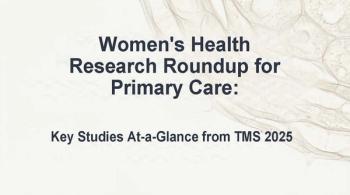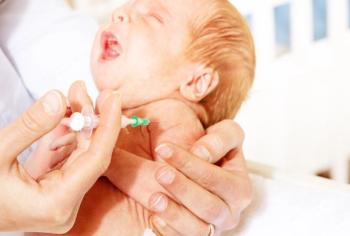
HIV and Hypertension: The Need to Pay More Heed
About a third of HIV-positive patients have high blood pressure. Is this a predictable consequence of ordinary aging, or do their history of HIV infection and treatment play a role? Whatever the explanation, many of these patients don't take the problem seriously enough.
As we age, our risk of high blood pressure and cardiovascular disease (CVD) increases -- and people with HIV are no exception. Recent studies find the prevalence of hypertension = ≥140/90 mmHg) among HIV-infected individuals to be as high as 34%.1,2
This appears to be fueled largely by traditional risk factors for hypertension with some, such as smoking, more common among HIV patients. So experts are calling for increased attention to prevention and treatment of high blood pressure as a chronic comorbidity in the HIV-positive population.
Efforts to manage hypertension face an extra challenge among HIV patients, who may consider elevated blood pressure to be the least of their worries.
“Some HIV patients believe that their HIV overshadows everything and minimize risks from behaviors such as smoking,” remarks Katherine Krauskopf MD MPH, assistant professor of medicine at New York’s Mount Sinai Medical School of Medicine and lead author of a 2013 study of hypertension among HIV patients. It was the first study of hypertension to include HIV patients with AIDS, Dr. Krauskopf adds, and because of the increased mortality among those patients, it’s unclear whether other HIV patients have the same risk of developing high blood pressure as those with AIDS.4The Role of Risk Factors
The observational cohort study of 2,390 patients with AIDS, followed at multiple clinical centers throughout the United States between 2009 and 2011, found a 22% prevalence of hypertension associated with metabolic risk factors (e.g., age, race, weight, and diabetes) -- but not with factors specific to HIV.3
Other studies find that HIV patients with high blood pressure are more likely to have traditional CVD risk factors -- to be male, to be current smokers, and to have low HDL (high density lipoprotein) cholesterol levels.5
Data also show that HIV-positive patients who develop hypertension and CVD, with a mean age of 50, tend to be 10-20 years younger than their uninfected counterparts -- an effect of an “accelerated aging” linked to HIV.4
“The fact that we see only the traditional risk factors for hypertension means high blood pressure and cardiovascular disease are not mediated largely through HIV but through other phenomena such as accelerated aging,” says Douglas Jabs MD a co-author of the Mount Sinai study. “One current hypothesis is that it is a by-product of the state of chronic inflammation that you see in HIV patients despite control of viral replication, despite immuno-restoration. They have a sort of heightened state of chronic inflammation that may be contributing to their vascular diseases.”
Writing in the journal Circulation in 2008,6 members of an interdisciplinary panel formed by the American Heart Association (AHA) observe that HIV “clearly causes structural and functional injury to the heart” and has other effects on the vasculature.”
For example, the Mount Sinai investigators find hypertension-associated changes in the vasculature of the eye. “Changes we see in the eye come from sophisticated grading of special photographs in the study that measures the caliber of the arteries and veins and allows us to evaluate the retinal vasculature and may provide new insights,” says Dr. Jabs, who is professor and chair of Ophthalmology and chair of the Studies of the Ocular Complications of AIDS (SOCA) Research Group, the cohort used in this study.
However, these retinal vascular effects are not something an ophthalmologist or optometrist could spot, he adds.
Suspected Effects of HIV
While the evidence may seem to favor accepted risk factors for hypertension comorbid with HIV, the authors of a 2013 review in the Journal of Cardiovascular Medicine feel that it’s too soon to exonerate the virus. “Given the high prevalence of hypertension and its association with duration of HIV infection,” they write, “other factors such as virally-mediated endothelial changes or immune activation may play a role.”7
Additionally, researchers observe that both CD4+ count and viral load influence CVD.
Even without HIV infection, chronic inflammation and T cell activation are thought to play a central role in atherosclerosis.4
“Our study also found an association between a longer time since diagnosis for HIV and higher CD4 count at the time and prevalent hypertension,” notes Dr. Krauskopf “That appears to exist in the context of the effects of the chronic exposure to viral and T-cell mediated response to ongoing HIV infection and/or robust T-cell response to therapy.”
A substantial body of research has documented potential effects of HIV virus on blood vessels, cholesterol, systemic inflammation, metabolic syndrome (a constellation of cardiovascular risk factors, including hypertension), and heart attack risk.
Among those effects:
• HIV infection of the vascular lining and smooth muscle cells, systemic inflammation, or lipid disorders may result in endothelial dysfunction, stiffness and constriction, fatty plaque formation, and a tendency to clotting, observed the AHA interdisciplinary panel.5
• In addition, they note inflammation and vascular dysfunction could also produce cardiomyopathy and dysfunction of the left ventricle leading to heart failure.5 (Symptoms of heart failure may be masked by dehydration or malnutrition due to AIDS or misdiagnosed, leading to delays in appropriate treatment.)5
• Abnormal fat distribution in HIV patients (dangerous intra-abdominal fat accumulating despite weight loss) is commonly associated with of metabolic syndrome and diabetes, which is highly prevalent among infected patients.2What About HAART?
The role of HAART in the pathogenesis of high blood pressure and heart attack risk remains unclear, says Mount Sinai’s Dr. Krauskopf.
HAART has been linked to a series of metabolic risk factors for hypertension that also increase risks for CVD and heart attack(8), including insulin resistance, diabetes, and elevated cholesterol and triglycerides, that also increase CVD and heart attack risk, but a review of 13 large observational studies found them almost evenly divided as whether HAART increases risks for hypertension and CVD.5
“We do know that certain classes of medications, especially some of the older medications like protease inhibitors (PIs), are associated with dyslipidemia,” Dr. Krauskopf observes.
Other effects seen with PIs and HAART:
• PIs appear to increase metabolic risks such as abnormal fat distribution.2
• Studies also show that PIs induce activation of the renin–angiotensin system, a key player in hypertension.5
• The antiretroviral drugs indinavir, lopinavir/ritonavir, didanosine, and abacavir are associated with a significantly increased risk of heart attack.8
• The longer patients remain on HAART, the greater their risk of heart attack.9
More recent research suggests it may be the combination of HIV, hypertension, and HAART that harms the heart.
Data from the observational Veterans Aging Cohort Study, reported at the 2012 Conference on Retroviruses and Opportunistic Infections (CROI), show those with HIV and hypertension had a 70% greater relative risk of an acute myocardial infarction (AMI) than controls.10 Newer data from the same study found an increased risk of AMI among HIV-infected veterans in general, and suggested that ART may contribute to that risk.11
“There is some evidence in terms of some of those metabolic outcomes to suggest that changing antiretroviral therapies might mitigate that those changes,” says Dr. Krauskopf. “But minimizing risk for hypertension and cardiovascular disease in HIV can be accomplished with means other than just switching ART regimens.”
As with other experts in the field, she stresses that the benefits of HAART outweigh the cardiovascular risks for most patients.
The Importance of Hypertension Control
A recent update from the Swiss HIV Cohort Study -- which identified hypertension and at least one other CVD risk factor in around 2% of 10,361 HIV patients in a one-year period – suggests that inadequate control of high blood pressure may be to blame.3
The 2013 literature review also concludes that since conventional risk factors play a major role in hypertension, management of HIV-infected patients “should receive the same emphasis given for the general population at high cardiovascular risk, including adequate blood pressure control according to international guidelines,” write the authors.8
Since ART has made HIV a largely chronic disease, Dr. Krauskopf favors using that model as a template for hypertension prevention and management.
“Patients often ask me should I take meds, should I change my meds, are they causing my cholesterol problems, are they causing my high blood pressure, my cardiovascular disease. But adherence is only part of the problem. We have to focus on lifestyle modification in these patients,” she says.
Among her suggestions:
• Do a comprehensive evaluation of patients’ health behaviors. What are they doing to stay healthy other than dealing with their HIV?
• Ask questions at every routine office visit including: Are they smoking, are they physically active, what are they eating?
• Focus on making key behavioral changes, such as smoking cessation.
• Find out how patients’ health beliefs may be affecting their choices, especially as to taking medications if they feel healthy and have no symptoms.
• Do not shift the focus away from controlling HIV. Aimfor adherence rates better than 95%.
“Ideally, the goal in developing new HIV medications is they should be metabolically neutral, but that has to happen in parallel with clinical practices paying attention to screening for risk factors and prevention and minimizing cardiovascular effects in HIV,” says Dr. Krauskopf. “We have to look at the big picture.”
References:
REFERENCES:
1. Medina-Torne S, Ganesan A, Barahona I, Crum-Cianflone NF.
Hypertension is Common among HIV-Infected Persons, But Not Associated with HAART.
Journal of the International Association of Providers of AIDS Care (JIAPAC)
(2012) 11:20-25.doi: 10.1177/1545109711418361.
2. Gazzaruso C, Bruno R, Garzaniti A,
et al.
Hypertension among HIV patients: prevalence and relationships to insulin resistance and metabolic syndrome.
J Hypertens.
(2003) 21:1377-1382. PMID: 12817187.
3.
Vital Signs: Awareness and Treatment of Uncontrolled Hypertension Among Adults - United States, 2003â2010.
Morbidity and Mortality Weekly Report
September 7, 2012 / 61:703-709.
4. Krauskopf K, Natta ML, Danis RP,
et al.
Correlates of hypertension in Patients with AIDS in the Era of Highly Active Antiretroviral Therapy.
J Int Assoc Provid AIDS Care
(2013) Jun 13. [Epub ahead of print] .
5. Ho JE, Hsue PY.
Ischaemic heart disease: Cardiovascular manifestations of HIV infection.
Heart
(2009) 95:1193-1202.6. Dube MP, Lipshultz SE, Fichtenbaum CJ,
et al.
for Working Group 3.
Effects of HIV infection and antiretroviral therapy on the heart and vasculature.
Circulation
(2008) 118:e36âe40.
7. Calò L, Caielli P, Maiolino G, Rossi G.
Arterial hypertension and cardiovascular risk in HIV-infected patients.
Journal of Cardiovascular Medicine
( 2013) 14:553-558.
8. Worm SW, Sabin C, Weber R,
et al.
Risk of Myocardial Infarction in Patients with HIV Infection Exposed to Specific Individual Antiretroviral Drugs from the 3 Major Drug Classes: The Data Collection on Adverse Events of Anti-HIV Drugs (D:A:D) Study.
J Infect Dis.
(2010) 201: 318-330. doi: 10.1086/649897.
9. Mary-Krause M, Cotte L, Simon A,
et al.
Increased risk of myocardial infarction with duration of protease inhibitor therapy in HIV-infected men.
AIDS
(2003) 17:2479-2486.
10. London S,
HIV Exacerbates Heart Risk from Hypertension.
Family Practice News Network.com Retrieved August 1, 2013.
11. Freiberg MS, Chang CH, Kuller LH,
et al.
HIV Infection and the Risk of Acute Myocardial Infarction.
JAMA Intern Med.
(2013) 173:614-622. doi:10.1001/jamainternmed.2013.3728..
Newsletter
Enhance your clinical practice with the Patient Care newsletter, offering the latest evidence-based guidelines, diagnostic insights, and treatment strategies for primary care physicians.


















































































































































































































































































